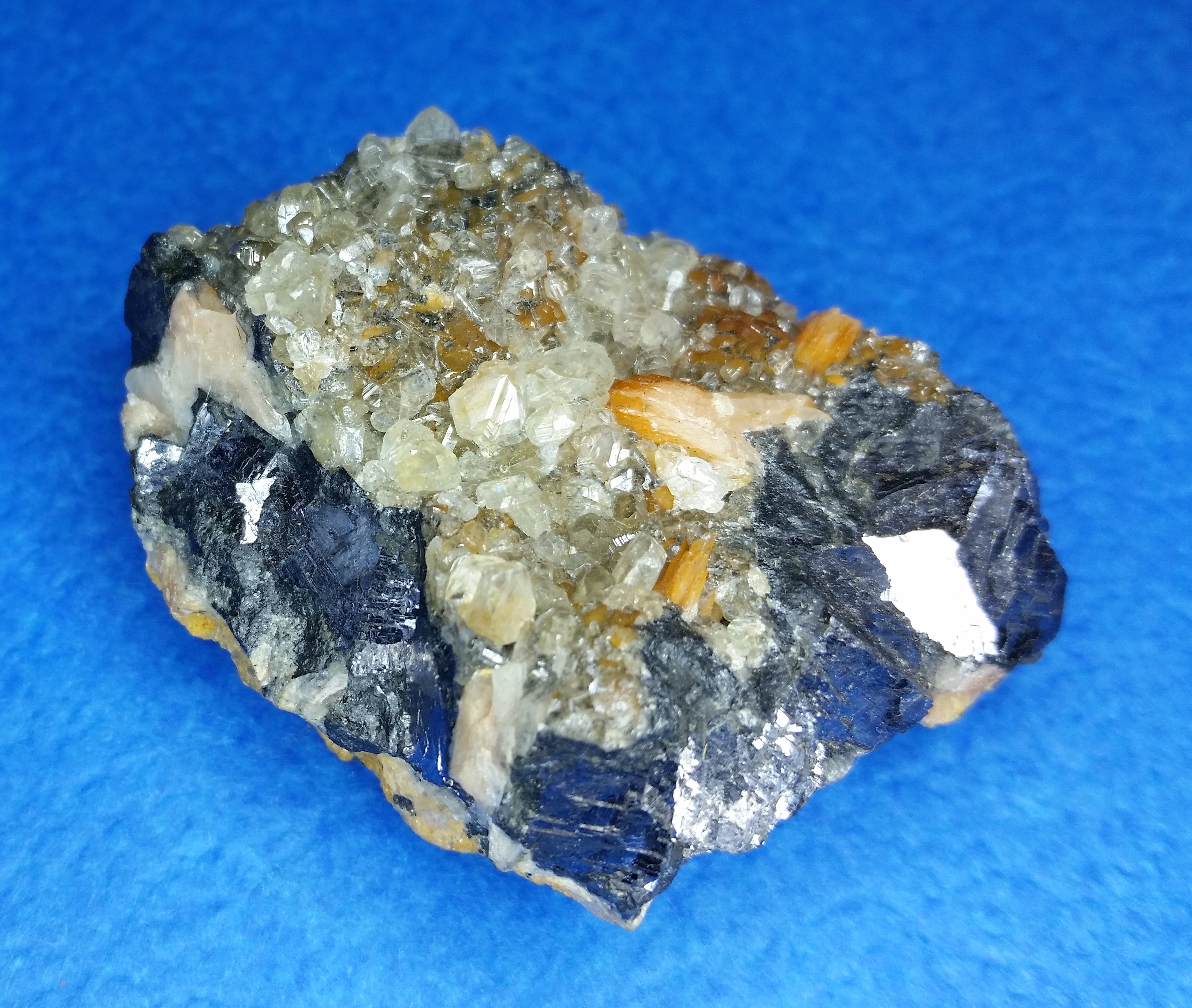 DRAFT
DRAFT 
Last update: 31 July 2019
| Many
radio books list cerussite, lead carbonate, as a usable detector
mineral, and the American Marconi Company used both Carborundum and
Cerusite (sic.) detectors. Years ago I procured a sample of
cerussite from a rock shop. |
||
 The clear and white crystals are cerussite, and they fluoresce yellow under UV light. However they do not conduct electricity, let alone have any rectifying qualities. The dark crystals are ordinary galena, lead sulfide.
Recently, I stumbled onto some cerusite references in Wireless Age, a magazine published by the American Marconi Company. One of the regular features was a questions and answers column.
July 1914, p 857
"A. L. G., New York City, asks: Will you kindly explain the use of cerusite as a detector? I have tried to use it in the same way as silicon and galena but without results.
Ans. Cerusite crystals other than those furnished by the Marconi Company are apt to be insensitive. It is used in the same manner as silicon or perikon. The contact point is generally steel. Cerusite detectors may be purchased from the Marconi Company for $50 each." (Thats $1200 in 2019 dollars. ed.)
November 1914, p155
“G. E. T .. Jubilee, N. B., writes:
Ques.-(2) Where can I obtain a cerusite crvstal without the detector stand?
Ans.-(2) These crystals are not sold without the stand. Complete detectors may be purchased from the Marconi Wireless Telegraph Company of America, 233 Broadway, New York City.”
January 1915, p320
"The Marconi wireless Telegraph Company of America controls the cerusite detector exclusively and concerns attempting to sell these crystals will be held liable."
June 1915, p667
"Receiving Detectors
Experimenters frequently ask the writer which of the crystalline detectors are the most suitable 'for the beginner. For the person who is absolutely uninformed on the adjustment of receiving detectors, the cerusite or the perikon detector are recommended. Cerusite possesses a peculiar property, practically the entire surface of the crystal is of equal sensibility. The perikon detector possesses somewhat similar characteristics, but not to the same degree. Galena and silicon crystals are difficult to adjust and to maintain in the sensitive condition. Carborundum crystals are nearly as sensitive as cerusite crystals and will hold their adjustments indefinitely. In fact such crystals are extremely rugged and highly desirable where considerable transmitting is done.
July
1919 p44 - “Quires Answered"
"R. D. W., Plainfield, N. J.: We do not know the nature of the crystals sold under the name of Lenzite and Radiocite. Regarding your experiments with cerusite: Genuine cerusite will not act as an oscillation detector in radio. What formerly was assumed to be cerusite was nothing more than a grade of galena of a different crystal formation than that ordinarily used by experimenters ."
|
||
| Analysis: I'm guessing that Marconi cerusite was what crystal set people call steel galena. Galena is the name of lead sulfide, a common lead ore found around the planet. Many forms of galena involve large silvery crystals. While these are visually attractive, and many will act as detectors of radio waves, the large smooth surfaces make it difficult to find and hold a sensitive spot. Steel galena has a fine crystal structure. The detector cat's whisker easily catches in one of the many notches, where it has about three chances of forming a working semiconductor junction. In addition, the whisker tends to stay lodged in one position. There is wide variation in the quality of galena for detector purposes from one mining site to another. I have some samples of fine grained galena from Colorado that are nearly useless as detectors. I suspect the sources of the good stuff were jealously guarded. Request for Help: I'd appreciate it if any of you who have access to Marconi equipment would take a look at the detectors, and let me know what you find. Here are some pictures to help identify the minerals: |
||
Ordinary Galena |
Steel Galena in 1/2" metal mount |
Carborundum |
| Dreaming: The Marconi type 101 receiver was used for comparison in Edwin Armstrong's demonstration of his regenerative receiver to Marconi personnel at the Marconi Belmar station in January 1914. That station later became the U.S. Army's Camp Evans, and is now the home of InfoAge and the Radio Technology Museum. Here's a quote from David Sarnoff's report: "Armstrong's receiver was compared with our standard 101 navy type tuner together with the cerusite and carborundum detectors. Speaking relatively of received signals means, of course, very little since the human ear is not to be depended upon, but an idea of the difference may be obtained when it is stated that signals from Clifden on Armstrong's receiver could be read with ease with telephones on the table when signals on our receiver were barely readable with the telephones on the ears ." |
||
| It would be really appropriate to have one of these radios in our museum next to our Armstrong regen reconstruction. |
||